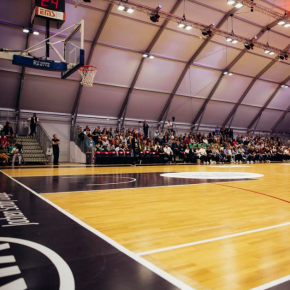
Four things you should know about temporary structures
The last 12 months has seen UK businesses thrown into turmoil about the state of the nation and with many not wanting to invest in bigger or new premises, the temporary structures industry has seen a boom in sales.
When it comes to expanding your business, whether you need a bigger warehouse facility to store new stock or somewhere to house larger equipment, these temporary operational spaces are not to be snubbed when making your considerations.
What are they?
Temporary structures are a building or a series of buildings that can be erected in a short amount of time, providing you will the tools you potentially need to continue your regular business operations.
Usually with a build time of around 7 – 28 days depending on the complexity of the design, their short lead time does not by any means make them flimsy.
How are they different to permanent structures?
A permanent structure, although longer lasting than their permanent cousin, has a much lengthier lead time of around two to six months. And, whereas permanent buildings require capital to outlay prior to installation, temporary buildings require little to no deposit.
What if your company needs to relocate in a short space of time? Another benefit of temporary structures is that they can be moved with little notice.
Many temporary buildings can be relocated and installed as many times as you need at as many different locations.
What are they used for?
Whether you’re looking for a new warehouse space or a temporary compartment for your offices while your new building is under construction, structures of this nature can be utilised by a variety of businesses.
These solutions are now used widely by fitness companies, with many installing permanent structures to offer a free space for employees to be able to exercise to help reduce stress, provide motivation and relax during the working day.
They’re often used by schools too, with many that are going through construction on site, using temporary structures for classroom space and sports halls, helping to minimise disruption to education.
Will they be your ideal solution?
With a small initial investment compared to a permanent structure and the ability to transform and expand your business whenever needed, temporary buildings are cost effective, better for the environment and can help your company transform faster than the competition.
When you’re next considering your options, weigh up all your options and include temporary structures as a viable option.
Latest news

26th July 2024
Enfield Speciality Doors completes world-class project for Atlas Copco HQ
A rundown office and warehouse building completely transformed into a modern headquarters for Atlas Copco has been fitted with more than 120 internal fire doors from Enfield Speciality Doors.
Posted in Access Control & Door Entry Systems, Articles, Building Industry News, Building Products & Structures, Building Systems, Case Studies, Doors, Interior Design & Construction, Interiors, Posts, Restoration & Refurbishment, Retrofit & Renovation, Security and Fire Protection, Sustainability & Energy Efficiency, Timber Buildings and Timber Products, Wooden products
26th July 2024
Abloy UK launches new white paper
Abloy UK, a leading provider of security and access control solutions, has launched a new white paper.
Posted in Access Control & Door Entry Systems, Architectural Ironmongery, Articles, Building Industry News, Building Products & Structures, Building Services, Doors, Facility Management & Building Services, Health & Safety, Information Technology, Innovations & New Products, Publications, Research & Materials Testing, Security and Fire Protection
26th July 2024
MCRMA Member Profile: David Roy, Director of Roofconsult
David Roy of MCRMA member company Roofconsult has more than 50 years’ experience to draw upon working in the building envelope sector and a unique perspective on how it has changed in that time.
Posted in Articles, BIM, Infrastructure & CAD Software, Building Associations & Institutes, Building Industry News, Building Products & Structures, Building Services, Building Systems, Cladding, Information Technology, Restoration & Refurbishment, Retrofit & Renovation, Roofs, Walls
26th July 2024
Strand: Enhancing Door Functionality and Safety
Craig Fox, Sales Director for Strand Hardware, outlines how door industry professionals might apply door limiting stays…
Posted in Architectural Ironmongery, Articles, Building Industry News, Building Products & Structures, Building Services, Doors, Facility Management & Building Services, Health & Safety, Restoration & Refurbishment, Retrofit & Renovation
 Sign up:
Sign up: